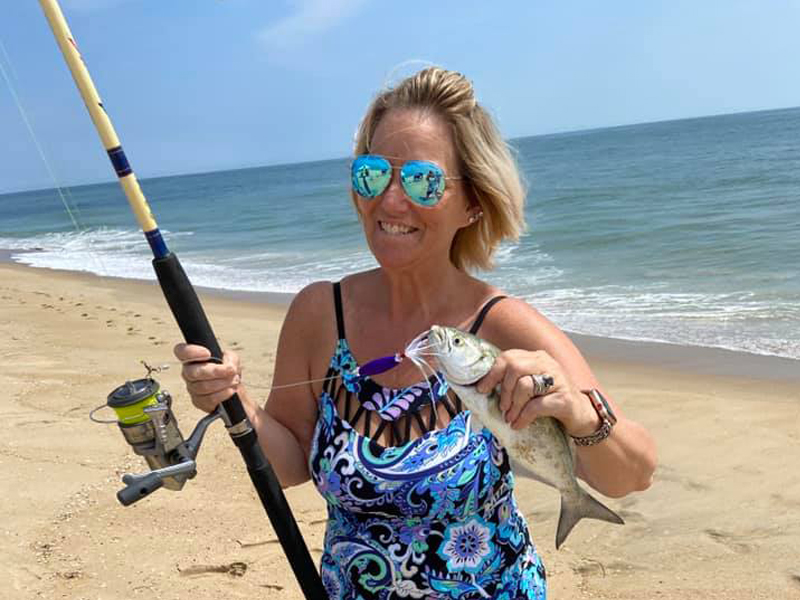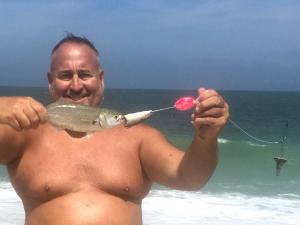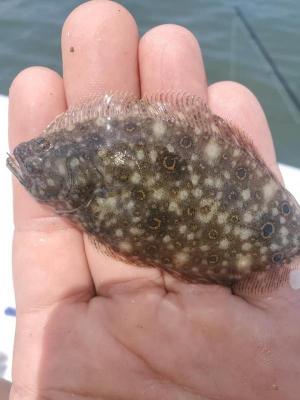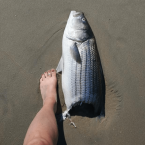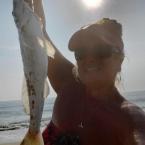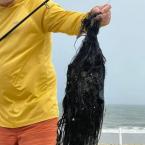Bluefish finally in town; flounder action picking up
If you haven’t been outside, we can cut the air with a butter knife now. Summertime is in full swing. No one blew anything up this past week, except the bluefish! Yeah buddy, the blues are finally in town, only about four weeks late. Must have been visiting Elvis with the pompano, who are still late to show. Those catches also just started, but slow and random on the southern beaches. Tautog season started July 1, and some anglers are doing OK at the walls in the Harbor of Refuge.
The flounder action at the Cape Henlopen pier is picking up a little more. Fish are a little larger and hitting on Gulp, or minnows on fluke rigs (single drop flounder rig), or jigging bucktails with or without Gulp. The Inland Bays flounder action and Lewes-Rehoboth Canal have been decent for the area. Hardest part of the Inland Bays is finding a place to fish on the weekend. The sandbars have taken over the bays, and that usually pushes fish elsewhere. All of those bars are on top of the mussel beds, which are buried and gone now. Not only a food source for fish, but also a reef-like structure for all kinds of life, and a natural filter for the waters.
Offshore and Delaware Bay flounder action is good on wrecks and reefs, but most anglers are concentrating on sea bass. That action has been hot on the good days. The weather has been cooperating for the boats most days. Tropical storm Elsa was an overnight blow and gone. Nothing like sleeping through a storm while phones are blowing up at midnight with tornado alerts.
Spot is hot at the Cape Henlopen fishing pier. Despite the lack of bloodworms due to supply issues cut off by tropical storm Elsa, anglers were killing it with Fishbites bloodworms. The other flavors of Fishbites, crab and sand flea, work well too. The orange colors help mimicking sand flea eggs. A Sabiki rig is great for spot, too. Doesn’t require bait because the small hooks, six of them, are set up with a little flash to attract a bite. You are allowed to use Sabiki rigs in Delaware for baitfish; spot are not only good for the table but killer for bait. We like to catch small spot, then live line them for flounder around the Inland Bays and pier. That is one reason more flounder are around these areas; spot is a good food source.
Croaker action has picked up around the Delaware Bay. The jetty at Bowers Beach was hot this past weekend. Good to see the croaker show up in numbers this year.
Striped bass fishing has changed up in the Delaware Bay for the summer. It is now striped bass summer slot season. The slot limit for Delaware Bay and its tributaries is 20-25 inches and two fish per angler per day. The season lasts from July 1 to Aug. 31.
The one issue some anglers have, much like striped bass season in the EEZ, is processing these fish in waters where they are not legal. For example, if you fish the Lewes-Rehoboth Canal and then run to the Inland Bays on your boat, you are now in possession of illegal striped bass.
Delaware Bay tributaries are just that – any waterway that dumps into the Delaware Bay. The Lewes-Rehoboth Canal is also a Delaware Bay tributary. Keeping slot-sized striped bass is legal only from the Freeman Highway Bridge to the Roosevelt Inlet. Yes, we think it is odd the entire canal is not a tributary like the rest of the tributaries. Canary Creek, Broadkill River, Mispillion River, Murderkill River, etc., are all tributaries. The entire Delaware Bay is under this slot season. These are the best-sized striped bass to eat, in my opinion. Unfortunately, the Inland Bays are not part of Delaware’s summer striped bass slot season. I wish that would change. It isn’t like it is a huge body of water, but the fishing is pretty good for short striped bass. There are even some keeper striped bass being caught around the inland bays and bridges in Ocean City.
Offshore sportfishing was on fire for the Ocean City Tuna Tournament. A lot of fish came to the scales. Apparently the tax man took a lot of fish before they got to the boat. Who is the tax man? Sharks will eat your catch on the retrieve. That is the “tax” for fishing out there or anywhere. The ocean is a violent environment; one minute you are feeding and the next you are the food. Fish on a line being reeled in are in distress and an easy target for predators.
Offshore anglers are catching the tax man, too, as well as tilefish, billfish and the usual suspects.
Support your local tackle shops and tackle manufacturers. DS Custom Tackle is a local manufacturer of quality fishing gear. They use better components than your typical “cheap” gear. It might cost a few cents more, but you are helping pay an American to work. Everyone always says buy American; here is your chance.
Crabbing and clamming have been great around the Inland Bays. Keeping your shellfish cold after catching them is highly recommended. This time of year, bacteria can be an issue, and warm shellfish will explode with bacteria. We also have vibrio issues in the later summer. Keeping the shellfish cool will keep the bacteria levels down until it is time to eat.
Freshwater fishing has been excellent for the bass anglers around the area ponds. Catfish are hitting much harder now that they are not spawning. Fly-fishing for the smaller pond fish has been fun. The fly anglers have been doing well in the flats areas for croaker and the like. Check out the Saltwater Fly Anglers of Delaware club. They are based in Lewes and meet monthly – great club. Probably a few hundred years of knowledge. They also meet at the Cape Henlopen fishing pier every two weeks and fish the flats as a group.
“Fleaing” for striped bass at night is a blast. Go to the Indian River Inlet at night, and set up in the darker areas. Get about half a five-gallon bucket of sand fleas. Put one on a four to six aught circle hook with no weights. Toss a few sand fleas into the water and then toss your line in the same spot. The short striped bass will feed like pigeons or gulls on those fleas you tossed in and then hit yours as well. Hold onto your rod good if using light gear; they hit hard and it is a lot of fun. You are now fleaing for striped bass.
By the way, you can eat sand fleas; they are delicious. We will get into that next week.
See ya in the sandbox.














